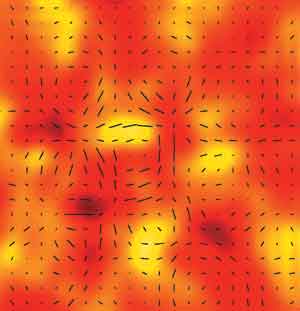 Investigations
Investigations
Brighter evidence of the Big
Bang
As University of Chicago physicist
Sean Carroll planned speakers for September's COSMO-02 workshop
in Chicago, John Carlstrom, the S. Chandrasekhar professor
in astronomy & astrophysics and the College, was not
on the agenda. But nine days before the event, Carroll shifted
the schedule so that Carlstrom could announce the latest
results from the Degree Angular Scale Interferometer (DASI).
Even then, Carroll did not tip his hand.
He wanted Carlstrom's announcement to come as a surprise
to the 275 cosmologists at the meeting. Carlstrom's news:
his team had succeeded in measuring the polarization of
the cosmic microwave background (CMB), or the sky-pervading
afterglow of the Big Bang.
Journalists also took note, to Carlstrom's
surprise. The New York Times, Chicago Tribune,
Reuters, and a host of other outlets covered the announcement.
"We assumed that we would make a big splash in our
own community," Carlstrom says, "but I was not
sure that the press would pick up on it."
|
|
DASI's view of the
CMB's polarization (black lines) and intensity, shown
in hot (yellow) and cold (red).
|
Despite the discovery's esoteric nature,
the news media were fairly accurate in defining polarization
and explaining its cosmological significance. Unlike the
radiation that DASI measured, most light is unpolarized,
its many individual waves jumbled together, each wave flickering
up and down on a different plane as it speeds toward Earth.
When unpolarized light from the Big Bang last interacted
with matter nearly 14 billion years ago, it became polarized,
and the waves began flickering along the same plane.
Astrophysicists had suspected the polarization
theory but had been unable to prove it, searching for a
signal with increasingly sensitive instruments for more
than two decades. Even with DASI, the Chicago team—working
at the National Science Foundation's Amundsen-Scott South
Pole Station—had to spend 271 days watching two spots in
the sky to measure the extremely weak signal with a high
degree of certainty.
But the painstaking effort paid off.
The framework that supports the entire edifice of modern
cosmological theory states that polarized light is an inescapable
characteristic of the Big Bang, which sent a series of sound
waves reverberating through the early universe. As electrons
sloshed back and forth within these sound waves, they polarized
the CMB. Polarization, therefore, directly measures these
movements. Given Carlstrom's findings last year—in which
DASI measured precise temperature differences in the CMB,
hot and cold spots indicating denser and less dense areas—"the
polarization should show the material sloshing about at
just the right level to make the hot and cold spots,"
Carlstrom says. And this is exactly what his recent findings
confirm.
The polarization is thus a signpost from
when the universe was only 400,000 years old, when matter
and light were just beginning to separate from one another.
"What's unique about polarization is that it directly
measures the dynamics in the early universe," Carlstrom
says. This means that when DASI calculates the polarization,
it actually measures the velocities of matter as it formed
into clumps for the first time.
The theoretical framework that polarization
supports encompasses a variety of unlikely interpretations
that cosmologists have pulled from their data in recent
years, Carlstrom says. If no polarization had been found,
cosmologists would have had to reject these interpretations.
"Instead of stating that we think we really understand
the origin and evolution of the universe with high confidence,
we would be saying that we just don't know," Carlstrom
says. "Polarization is predicted. It's been detected,
and it's in line with theoretical predictions. We're stuck
with this preposterous universe."
What makes it so preposterous is that
ordinary matter-the stuff of which humans, stars, and galaxies
are made-accounts for less than 5 percent of the universe's
total mass and energy. The rest is made of a mysterious
force called dark energy. Scientists simply do not know
what the force is. They only know that it acts in opposition
to gravity, accelerating the expansion of the universe.
DASI's polarization reinforces this paradoxical interpretation,
and more besides.
This includes cosmic inflation, an extension
of the Big Bang theory, which improbably proposes that just
moments after the Big Bang the universe underwent a gigantic
growth spurt in a fraction of a second. Although inflation
forms the basis for much of contemporary cosmology, scientists
have yet to reconcile it with prevailing theories of fundamental
physics.
Carlstrom next expects to use DASI for
more precise polarization measurement. He'll also use a
newly funded South Pole telescope "to measure the polarization
with very high precision," he says, "and move
toward the longer-term goal of measuring the primordial
gravitation waves from inflation through their subtle effect
on the CMB polarization."
Gravity waves are a form of radiation
predicted by general relativity that correspond to ripples
in the fabric of space-time, says Michael Turner, the Bruce
V. and Diana M. Rauner distinguished service professor in
astronomy & astrophysics. "Detection of the polarization,"
Turner says, "opens a new door to exploring the earliest
moments and answering the deep questions before us."
— Steve Koppes


![]() Contact
Contact
![]() About
the Magazine
About
the Magazine ![]() Alumni
Gateway
Alumni
Gateway ![]() Alumni
Directory
Alumni
Directory ![]() UChicago
UChicago![]() ©2002 The University
of Chicago® Magazine
©2002 The University
of Chicago® Magazine ![]() 5801 South Ellis Ave., Chicago, IL 60637
5801 South Ellis Ave., Chicago, IL 60637![]() fax: 773/702-0495
fax: 773/702-0495 ![]() uchicago-magazine@uchicago.edu
uchicago-magazine@uchicago.edu
